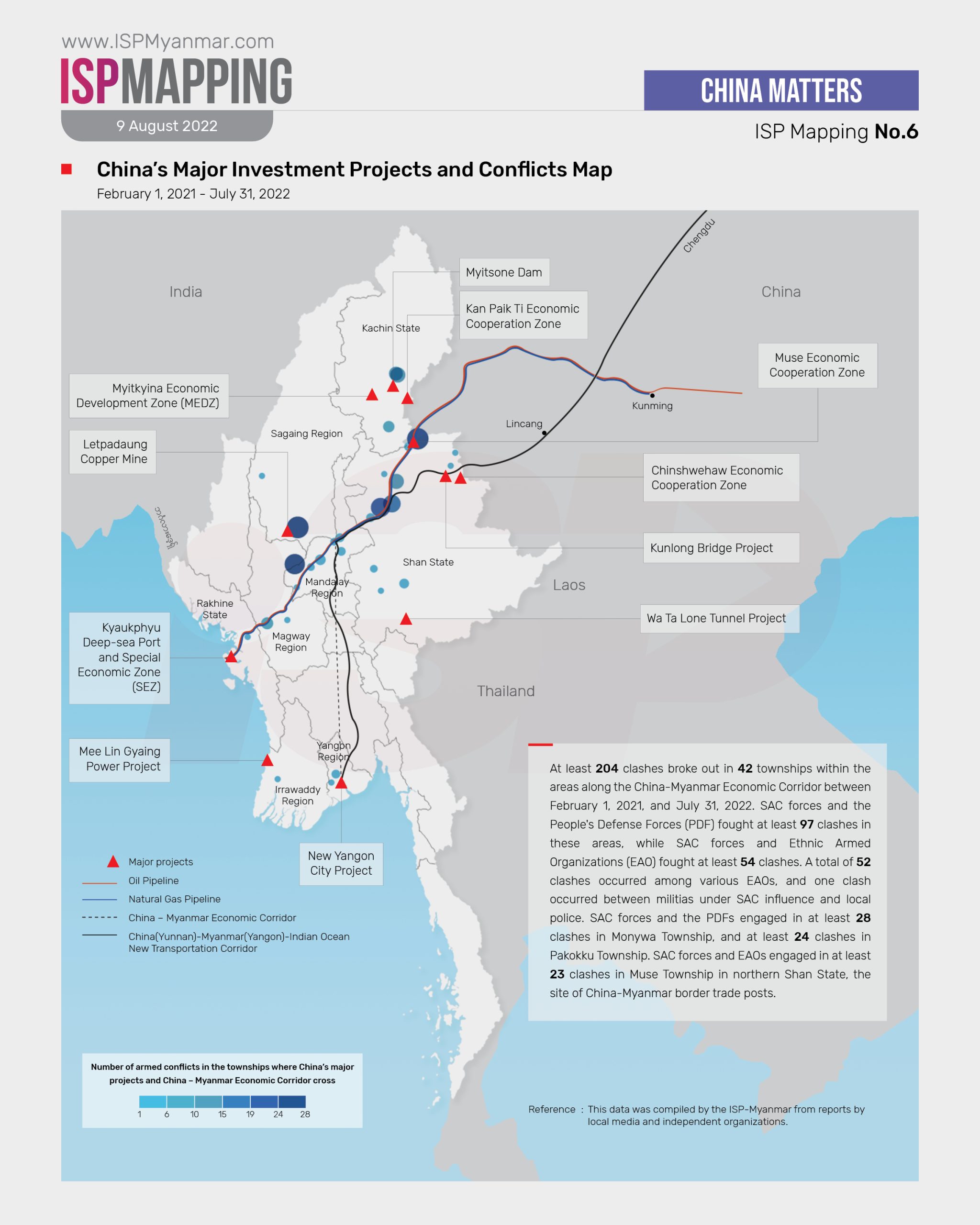(ISP Mapping No.6)
(This article is a translation of the Burmese language version that ISP-Myanmar posted on its Facebook page on August 9, 2022.)

Since the military coup in February 2021, the conflict map of Myanmar has become broader and larger as a result of armed conflicts between SAC forces and ethnic armed organizations, as well as between SAC forces and newly formed local defense forces. A number of China’s major projects have either come under attack or have been threatened as a result of conflicts in project areas. Most clashes took place in the area surrounding the Letpadaung Copper Mine. Later in June, Wanbao announced that it had suspended operations at the mine for more than 16 months.
China has repeatedly stressed the importance of securing the Myanmar-China oil pipeline since the coup. During an official visit to Myanmar ahead of the Mekong-Lancang Cooperation Foreign Ministers’ Meeting in early July, China’s Foreign Minister Wang Yi discussed security guarantees for the China-Myanmar oil pipeline with the SAC-appointed foreign minister. China is clearly focused on resuming its Belt and Road Initiative, as it discussed enhancing the China-Myanmar Economic Corridor.
Armed conflicts dramatically increased in 42 townships along the China-Myanmar Economic Corridor between January 1, 2022, and July 31, 2022, compared to attacks in all of 2021. Attacks against SAC forces have also become more frequent as the people’s defense forces in central Myanmar become more powerful.
∎ Attacks on China’s Major Projects and Other Battles
At least 204 clashes broke out in 42 townships across 10 Regions and States—home to China-Myanmar Economic Corridor projects—between February 1, 2021, and July 31, 2022, according to figures compiled by the ISP-Myanmar. SAC forces and the People’s Defense Forces (PDF) clashed at least 97 times in these townships, while SAC forces and Ethnic Armed Organizations (EAOs) clashed at least 54 times. A total of 52 clashes occurred among various EAOs, and one clash occurred between militias under SAC influence and local police.
At least 28 clashes took place between SAC forces and local defense forces in Monywa Township near the Letpadaung Copper Mine, a project of the China-Myanmar Economic Corridor. Since the coup, Monywa Township has seen the majority of clashes occurring near Chinese projects. SAC forces and PDFs clashed at least 24 times in Pakokku township, where the China-Myanmar oil and natural gas pipelines intersect. Meanwhile, 19 clashes occurred among different EAOs in Kyauk Me Township, where the pipelines also cross, along with another 14 in Hsipaw Township, and another 12 in Namtu Township. SAC forces and EAOs clashed 23 times in Muse Township in northern Shan State, the site of China-Myanmar border trade posts.
∎ Why Does it Matter?
China’s perception of its policy toward Myanmar may be greatly impacted by attacks on its major projects in the aftermath of the coup, amid the omnipresent armed conflicts throughout the country. In particular, China may alter its perception and response to newly emerging forces. It is necessary to observe carefully whether the military actions of EAOs in Shan State and their attempt to gain military and territorial dominance represent China’s power-domination policy or a measure to ensure security. This is especially important because of the junction of Chinese projects in this region, particularly along the economic corridor. It is crucial to keep an eye on the stance and response of newly established Local Defense Forces to Chinese interests, which could influence China’s policy shift regarding Myanmar.
∎ Other Relevant Readings
The correlation between the armed conflicts following the coup and China’s projects can be examined through coverage of the on-the-ground situation by independent media, local media based in ethnic minority areas, Chinese embassy statements, Chinese media coverage, and the reports and documentation of independent international and local organizations.

